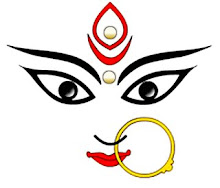 |
| The JwalaMukhi Temple |
One of the Tantra Temples, it is a note worthy fact that there is no idol in it. An eternally burning and shining blue flame emanating from a rock sanctum is only worshipped here as a manifestation of the goddess. Dedicated to the deity of Flaming Mouth or goddess Jwalamukhi, the temple is one of the 51 power spots or Shaktipeethas of India. One of the most revered temples of the Hindus, the temple possesses a golden dome, gifted by Mughal Emperor Akbar. The temple is at its best during Navratri festival in early April and mid October.
 |
| Inner Portion of the Temple |
Dating back to the origin of Adishakti or Sati, the temple basks in a glorious past. It was to get respite from the unending atrocities of the demons that the gods concentrated their individual energies at one point, thus giving birth to Sati. Brought up in the house of Prajapati Daksha, Sati got married to Lord Shiva later.
Once Prajapati Daksha organized a yajna and invited al the gods and goddesses to it barring Lord Shiva. Sati wanted to partake in this grand affair so she reached the place of the Yajna uninvited. All her sisters were welcomed by her father there except her. Daksha did not even dedicate the sacred portion of the Yajna Prasad to Lord Shiva. This made Sati feel immensely humiliated. Therefore, she immolated herself in the fire of the Yajna.
Sati's end disturbed the Lord Shiva immensely. He sliced Daksha's head. On his reparation, the Lord affixed the head of a male goat to him. Unable to restore his mental peace even then, He roamed in the entire universe carrying Sati's burnt body. Foreseeing a calamity approaching, the gods requested Lord Vishnu to diffuse the anger of Shiva. At this, Lord Vishnu cut apart Sati's body into several pieces with his Sudharshan Chakra. Wherever those pieces of sati's body fell on earth, a shaktipeetha or the power centre of the goddess came up.
The Jwalamukhi temple is the place where Sati's tongue fell. The goddess therefore is manifested as tiny flames here that burn through the fissures in an age old rock. There are nine flames at the temple that have been burning here without any oil or cotton since ages.
 |
| A Temple with a Strong Historical Background |
 |
| Pathway Around the Temple |
 |
| View of the Jwala Mukhi Temple |
Legend behind the Temple
Jwalamukhi refers to the deity with flaming mouth. As per the legends, the mouth of Sati fell here at the time of self-sacrifice. Ever since, the Goddess occupied the place and she manifested in nine flames. After years, one day Raja Bhumi Chand Katoch, a resident of Kangra and a great devotee of Goddess Durga, dreamt of the holy place.
 |
| The JwalaMukhi Temple Dome |
Legend about Akbar, the Mughal Emperor
During the ruling period of Akbar, he learned about the legends of Jwalamukhi. In a fit of anger, he tried to douse the flames with a stream of water. The great power of the Goddess, still kept the flames burning. Realizing the power of Jwala Devi, Akbar came with his army to this temple. He brought a Gold umbrella [Chatra] for the Goddess, but on offering, the umbrella turned into an unknown metal suggesting that the Goddess didn't accept his offering.
 |
| The Towering peak of Jwala Mukhi Temple |
 |
| Airial View of the Temple of JwalaMukhi |
By Rail - The nearest narrow gauge railhead is Jawalaji road Ranital at a distance of 20 km from the shrine.The nearest broadgauge railhead is Pathankot at a distance of 120kms.Chandigarh Rly Station is at a Distance of 200 Kms.
By Road - Motorable roads connect this Shrine from Delhi, Chandigarh & Dharamshala. Taxis can be hired from these places.This all is hilly area with a beautiful scenic view all along the valley. Frequent state transport bus service is available from all important cities of Punjab, Haryana, New Delhi and J & K. The shrine is well connected by road. Frequent bus and taxi services are available.























No comments:
Post a Comment